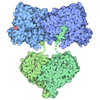[English] 日本語
 Yorodumi
Yorodumi- PDB-4erm: Crystal structure of the dATP inhibited E. coli class Ia ribonucl... -
+ Open data
Open data
- Basic information
Basic information
| Entry | Database: PDB / ID: 4erm | ||||||
|---|---|---|---|---|---|---|---|
| Title | Crystal structure of the dATP inhibited E. coli class Ia ribonucleotide reductase complex at 4 Angstroms resolution | ||||||
 Components Components | (Ribonucleoside-diphosphate reductase 1 subunit ...) x 2 | ||||||
 Keywords Keywords | OXIDOREDUCTASE / protein-protein complex / alpha/beta barrel / atp cone / di-iron center / RNR alpha / RNR beta / thioredoxin / Ribonucleotide reduction / Cytosol | ||||||
| Function / homology |  Function and homology information Function and homology informationribonucleoside diphosphate metabolic process / 2'-deoxyribonucleotide biosynthetic process / nucleobase-containing small molecule interconversion / ribonucleoside-diphosphate reductase complex / ribonucleoside-diphosphate reductase / ribonucleoside-diphosphate reductase activity, thioredoxin disulfide as acceptor / deoxyribonucleotide biosynthetic process / protein folding chaperone / iron ion binding / ATP binding ...ribonucleoside diphosphate metabolic process / 2'-deoxyribonucleotide biosynthetic process / nucleobase-containing small molecule interconversion / ribonucleoside-diphosphate reductase complex / ribonucleoside-diphosphate reductase / ribonucleoside-diphosphate reductase activity, thioredoxin disulfide as acceptor / deoxyribonucleotide biosynthetic process / protein folding chaperone / iron ion binding / ATP binding / identical protein binding / cytosol / cytoplasm Similarity search - Function | ||||||
| Biological species |  | ||||||
| Method |  X-RAY DIFFRACTION / X-RAY DIFFRACTION /  SYNCHROTRON / SYNCHROTRON /  FOURIER SYNTHESIS / Resolution: 3.95 Å FOURIER SYNTHESIS / Resolution: 3.95 Å | ||||||
 Authors Authors | Zimanyi, C.M. / Drennan, C.L. | ||||||
 Citation Citation |  Journal: Structure / Year: 2012 Journal: Structure / Year: 2012Title: Tangled up in knots: structures of inactivated forms of E. coli class Ia ribonucleotide reductase. Authors: Christina M Zimanyi / Nozomi Ando / Edward J Brignole / Francisco J Asturias / Joanne Stubbe / Catherine L Drennan /  Abstract: Ribonucleotide reductases (RNRs) provide the precursors for DNA biosynthesis and repair and are successful targets for anticancer drugs such as clofarabine and gemcitabine. Recently, we reported that ...Ribonucleotide reductases (RNRs) provide the precursors for DNA biosynthesis and repair and are successful targets for anticancer drugs such as clofarabine and gemcitabine. Recently, we reported that dATP inhibits E. coli class Ia RNR by driving formation of RNR subunits into α4β4 rings. Here, we present the first X-ray structure of a gemcitabine-inhibited E. coli RNR and show that the previously described α4β4 rings can interlock to form an unprecedented (α4β4)2 megacomplex. This complex is also seen in a higher-resolution dATP-inhibited RNR structure presented here, which employs a distinct crystal lattice from that observed in the gemcitabine-inhibited case. With few reported examples of protein catenanes, we use data from small-angle X-ray scattering and electron microscopy to both understand the solution conditions that contribute to concatenation in RNRs as well as present a mechanism for the formation of these unusual structures. | ||||||
| History |
|
- Structure visualization
Structure visualization
| Structure viewer | Molecule:  Molmil Molmil Jmol/JSmol Jmol/JSmol |
|---|
- Downloads & links
Downloads & links
- Download
Download
| PDBx/mmCIF format |  4erm.cif.gz 4erm.cif.gz | 776.4 KB | Display |  PDBx/mmCIF format PDBx/mmCIF format |
|---|---|---|---|---|
| PDB format |  pdb4erm.ent.gz pdb4erm.ent.gz | 655.1 KB | Display |  PDB format PDB format |
| PDBx/mmJSON format |  4erm.json.gz 4erm.json.gz | Tree view |  PDBx/mmJSON format PDBx/mmJSON format | |
| Others |  Other downloads Other downloads |
-Validation report
| Arichive directory |  https://data.pdbj.org/pub/pdb/validation_reports/er/4erm https://data.pdbj.org/pub/pdb/validation_reports/er/4erm ftp://data.pdbj.org/pub/pdb/validation_reports/er/4erm ftp://data.pdbj.org/pub/pdb/validation_reports/er/4erm | HTTPS FTP |
|---|
-Related structure data
| Related structure data |  5430C  5431C  5432C  5433C  5434C  5435C  5436C  5437C 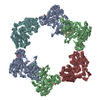 4erpC  3uusS S: Starting model for refinement C: citing same article ( |
|---|---|
| Similar structure data |
- Links
Links
- Assembly
Assembly
| Deposited unit | 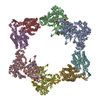
| ||||||||
|---|---|---|---|---|---|---|---|---|---|
| 1 |
| ||||||||
| Unit cell |
|
- Components
Components
-Ribonucleoside-diphosphate reductase 1 subunit ... , 2 types, 8 molecules ABCDEFGH
| #1: Protein | Mass: 85877.086 Da / Num. of mol.: 4 Source method: isolated from a genetically manipulated source Source: (gene. exp.)   References: UniProt: P00452, ribonucleoside-diphosphate reductase #2: Protein | Mass: 43426.863 Da / Num. of mol.: 4 Source method: isolated from a genetically manipulated source Source: (gene. exp.)   References: UniProt: P69924, ribonucleoside-diphosphate reductase |
|---|
-Non-polymers , 5 types, 28 molecules 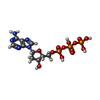








| #3: Chemical | ChemComp-DTP / #4: Chemical | ChemComp-DAT / #5: Chemical | ChemComp-MG / #6: Chemical | ChemComp-FEO / #7: Water | ChemComp-HOH / | |
|---|
-Experimental details
-Experiment
| Experiment | Method:  X-RAY DIFFRACTION / Number of used crystals: 1 X-RAY DIFFRACTION / Number of used crystals: 1 |
|---|
- Sample preparation
Sample preparation
| Crystal | Density Matthews: 3.08 Å3/Da / Density % sol: 60.07 % |
|---|---|
| Crystal grow | Temperature: 298 K / Method: vapor diffusion, hanging drop / pH: 7.5 Details: Precipitant conditions: 10% PEG 3350, 0.1 M MOPS pH 7.5, 0.2 M Magnesium Acetate, 0.025 M Magnesium Chloride, 0.006 M n-Nonyl-beta-D-maltopyranoside, and 5% glycerol. Mixed 1:1 with protein. ...Details: Precipitant conditions: 10% PEG 3350, 0.1 M MOPS pH 7.5, 0.2 M Magnesium Acetate, 0.025 M Magnesium Chloride, 0.006 M n-Nonyl-beta-D-maltopyranoside, and 5% glycerol. Mixed 1:1 with protein., VAPOR DIFFUSION, HANGING DROP, temperature 298K |
-Data collection
| Diffraction | Mean temperature: 100 K |
|---|---|
| Diffraction source | Source:  SYNCHROTRON / Site: SYNCHROTRON / Site:  APS APS  / Beamline: 24-ID-C / Wavelength: 0.9794 Å / Beamline: 24-ID-C / Wavelength: 0.9794 Å |
| Detector | Type: ADSC QUANTUM 315 / Detector: CCD / Date: Feb 25, 2011 |
| Radiation | Monochromator: Si(111) / Protocol: SINGLE WAVELENGTH / Monochromatic (M) / Laue (L): M / Scattering type: x-ray |
| Radiation wavelength | Wavelength: 0.9794 Å / Relative weight: 1 |
| Reflection | Resolution: 3.95→30 Å / Num. all: 55058 / Num. obs: 53173 / % possible obs: 96.6 % / Observed criterion σ(F): 0 / Observed criterion σ(I): 0 / Redundancy: 2.9 % / Rsym value: 0.161 / Net I/σ(I): 5 |
| Reflection shell | Resolution: 3.95→4.09 Å / Redundancy: 2.9 % / Mean I/σ(I) obs: 2.3 / Num. unique all: 5306 / Rsym value: 0.457 / % possible all: 96.5 |
- Processing
Processing
| Software |
| |||||||||||||||||||||||||
|---|---|---|---|---|---|---|---|---|---|---|---|---|---|---|---|---|---|---|---|---|---|---|---|---|---|---|
| Refinement | Method to determine structure:  FOURIER SYNTHESIS FOURIER SYNTHESISStarting model: 3UUS Resolution: 3.95→30 Å / σ(F): 0 / Stereochemistry target values: Engh & Huber
| |||||||||||||||||||||||||
| Refinement step | Cycle: LAST / Resolution: 3.95→30 Å
| |||||||||||||||||||||||||
| Refine LS restraints |
| |||||||||||||||||||||||||
| LS refinement shell | Resolution: 3.95→4.09 Å
|
 Movie
Movie Controller
Controller


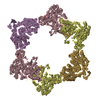
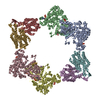
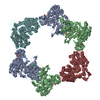
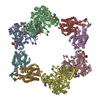
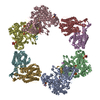



 PDBj
PDBj